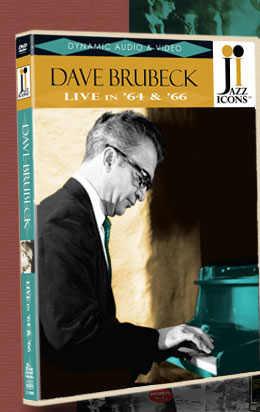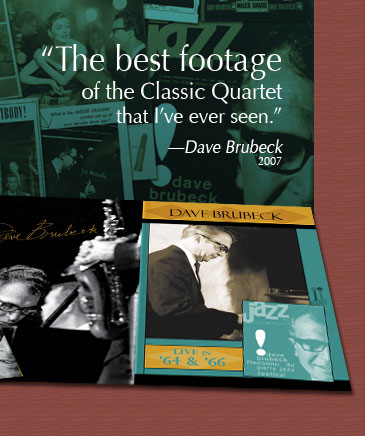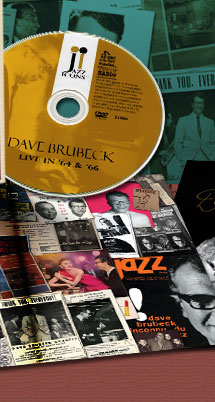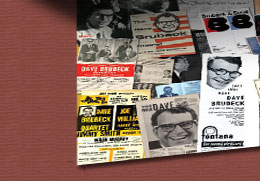




 |
 |
|
|||
|
|
|
||||
|
|
|
||||
|
|
|
||||
|
|
|
||||
 |
|
||||
 |
|
||||
 |
|
||||
|
|
|
|
|
|
|
Jazz Icons: Dave Brubeck boasts two beautifully filmed concerts from one of the most beloved quartets in jazz history. Captured at the pinnacle of their power and popularity, Paul Desmond (alto sax), Joe Morello (drums), Eugene Wright (bass) and Dave Brubeck (piano) explore the trails they blazed into the realm of odd time signatures with "Forty Days" and two versions of their groundbreaking hit "Take Five", as well as forays into world music with two unique interpretations of "Koto Song". Their intimate onstage chemistry and impeccable musicianship made the DBQ an award-winning jazz supergroup. |
|
 |
|
|
Piano- Dave Brubeck Alto Sax- Paul Desmond Bass- Eugene Wright Drums- Joe Morello |
|
 |
|
|
Piano- Dave Brubeck Alto Sax- Paul Desmond Bass- Eugene Wright Drums- Joe Morello |
|
24-page booklet Liner notes by Darius Brubeck Foreword by Doug Ramsey Cover photo by Gus Schuettler Booklet photos by Chuck Stewart, Lee Tanner, Jan Persson, Susanne Schapowalow, Ray Avery Memorabilia collage Total time: 67 minutes |
|
|
Foreword: Aside from its music, which is among the best I have heard in hundreds of hours of listening to the classic Dave Brubeck Quartet, this DVD reveals an essential element of the band’s huge success. Concert audiences made the Brubeck group a phenomenon, at first on college campuses, then in the world at large, and those audiences could see the genuine esteem and fondness Brubeck, Desmond, Wright and Morello had for one another. Without a trace of artifice or overt showmanship, the four radiated the enjoyment they got from playing together. It was infectious. People who may not have known a quarter note from a mouthpiece were captivated as they shared in the quartet’s naturalness and ease within the creative process. Listen to the staid German audience come alive when they recognize the 5/4 vamp that introduces “Take Five.” By the mid-’60s, the band’s single record of the piece had sold more than a million copies and a time signature unusual to jazz had become water the quartet swam in. They played “Take Five” every night for nearly a decade, never the same way twice, and it got better as time went by. If you wish to see 5/4 time, watch for the shot of Dave’s heel keeping it—1,2,3-1,2; 1,2,3-1,2. I wonder if he sleeps in 5/4. —Doug Ramsey
Sample Liner Notes by Darius Brubeck: My father says this is the best footage of the classic Dave Brubeck Quartet he has ever seen. Certainly it shows the Quartet as I remember it, remarkable for its consistency and group cohesion, yet just as remarkable for the unpredictable moments that made each performance of often-repeated material dramatically different. The DVD consists of two parts, recorded in Belgium (1964) and Germany (1966). The selections give both concerts a sense of reprising the group’s history. “I’m in a Dancing Mood” was carried over from one of Dave’s early quartets and “Forty Days” is the break-out number from The Light In The Wilderness, an oratorio Dave was still working on when he disbanded this famous Quartet in 1967. “In Your Own Sweet Way” comes from the period when the DBQ (not yet this quartet) was receiving attention on the U.S. club circuit and at the first Newport festival as a modern jazz combo with a noticeably articulate, clean-living, intellectual-looking pianist-leader. The iconic portrait of Dave with horn-rim glasses was featured on the cover of Time in 1954. (Duke Ellington knocked on the door of Dave’s hotel room to show it to him and Dave was initially more embarrassed than pleased. “It should have been you,” was all he could say.) “Koto Song”, written on tour in Japan in May 1964, is from the international era that began in 1958, the year Eugene Wright, the newest member, joined the band for a U.S. State Department tour. (It was on this tour that Dave made notes on rhythms he heard in Turkey, Afghanistan and India.) To this day, it is a rare Dave Brubeck concert that doesn’t end with “Take Five”. This DVD has two versions and the Brussels set features a 5/4 solo by Joe Morello, perhaps the first jazz drummer ever to do anything like this. Taken as a whole, the DVD is historically valuable because it shows the Quartet at the peak of its global popularity and in top form. And yet, these are simply two sets that happened to be recorded in an itinerary that included 100 concerts a year, the odd club gig, TV show, award event and a mandatory three albums. The DBQ kept this up from 1958 to 1967. ... "Take Five", as I’ve already implied, was often better in performance than the hit single recorded in 1959, at least from a jazz perspective. Dave uses the famous vamp to set a somewhat faster tempo but he no longer has to vamp throughout. Free to comp, the piano adds a subtle layer of colour and rhythm that was absent six years earlier. Joe’s beat is constant but flexible and his solo is relaxed and musically concise. Everyone is cruising along, appreciating the good company they’re in and it’s cool and low-key all the way, even though it’s their umpteenth rendition of a massive hit. Joe’s drum solo is very fresh sounding and provides a mature musical statement, very clean, no clutter. This is truly a great version and I’ve heard hundreds. ... “I’m In A Dancing Mood” by contrast is all surface; a playful melody in a series of pre-composed variations, not unlike a soundtrack to a Gene Kelly sequence. Dave said he worked this out in a nightclub in Toronto with Norman Bates (bass) and Joe Dodge (drums) and Paul missed the rehearsal. It’s funny that Paul still doesn’t play much on this number, because after it was a big hit with the audience, Paul said, “Dave, I’ll never miss another rehearsal.” ... “Koto Song” here is a fine example of intuitive playing and “noh” playing especially when Gene and Joe reduce the pulse to near non-existence. Dave’s and Paul’s solos are both highly chromatic despite the koto-scale premise. The piano builds gorgeously dissonant ink-wash clouds of sound like Toru Takemitsu, not because of any direct influence but, rather, that Toru and Dave both drew on a blending of Debussy, Messiaen, Japanese folk music and jazz. All words and artwork on this page ©Reelin' In The Years Productions. Unauthorized use is prohibited.
|
|
Site contents ©Copyright 2007 Reelin' In The Years Productions
Site designed by Tom Gulotta